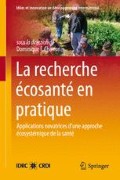Abstract
Au début des années 1990, l’Équateur, comme beaucoup d’autres pays, a connu une forte croissance économique qui a eu pour conséquences une concentration soudaine des richesses et une exclusion sociale qui a marginalisé les plus démunis. Le développement économique rapide de cette période a entraîné la dégradation de l’environnement qui, à son tour, a eu des effets néfastes sur la santé humaine et amplifié la pauvreté (Breilh et Tillería 2009).
Access this chapter
Tax calculation will be finalised at checkout
Purchases are for personal use only
Notes
- 1.
Consorcio de Capacitación para el Manejo de los Recursos Naturales Renovables. http://www.camaren.org/ (site en espagnol); http://cap-net.org/.
- 2.
- 3.
Pour en savoir plus sur le FLP en Équateur, voir http://www.fairflowers.de.
Bibliographie
Aguirre, P. (2004). Effect of Pesticides on Soil Quality: The Case of Ecuadorian Floriculture. Thèse de doctorat, Université Göttingen, Göttingen, Allemagne.
Alavanja, M., Hoppin, J., et Kamel, F. (2004). « Health Effects of Chronic Pesticide Exposure: Cancer and Neurotoxicity », Annual Review of Public Health, vol. 25, p. 155–197.
Breilh, J. (2004). Epidemiología Crítica (2e édition). Lugar Editorial, Buenos Aires, Argentine.
——— (2007). « Nuevo Modelo de Acumulación y Agroindustria: Las Implicaciones Ecológicas y Epidemiológicas de la Floricultura en Ecuador », Ciencia e Saude Coletiva, vol. 12, no 1, p. 91–104.
Breilh, J., Campaña, M., Felicita, O., Hidalgo, F., de Lourdes, M., et Sánchez, D. (2009). Informe técnico final : Consolidación del Estudio Sobre la Relación entre Impactos Ambientales de la Floricultura, Patrones de Exposición y Consecuencias en Comunidades de la Cuenca del Granobles (Sierra Norte, Ecuador). Rapport technique final remis au CRDI (projet n° 103697) (en espagnol). Centro de Estudios y Asesoría en Salud (CEAS), Quito, Équateur. http://idl-bnc.idrc.ca/dspace/handle/10625/45111.
Breilh, J., Campaña, M., Hidalgo, F., Sanchez, D., Larrea, M.L., Felicita, O., Valle, E., MacAleese, J., Lopez, J., Handal, A., Zapatta, A., Maldonado, P., Ferrero, J., et Morel, S. (2005). « Floriculture and the Health Divide: A Struggle for Fair and Ecological Flowers », dans CEAS (dir.), Latin American Health Watch: Alternative Latin American Health Report. Latin America Health Watch, Quito, Équateur. http://www.scribd.com/doc/14954917/Latin-America-Health-Watch.
Breilh, J., Pagliccia, N., et Yassi, A. (2012). « Chronic Pesticide Poisoning from Persistent Low-Dose Exposures in Ecuadorian Floriculture Workers: Towards Validating a Low-Cost Test Battery », International Journal of Occupational and Environmental Health, vol. 18, no 1, p. 7–21.
Breilh, J., et Tillería, Y. (2009). Aceleración Global y Despojo en Ecuador: El Retroceso del Derecho a la Salud en la Era Neoliberal. Universidad Andina y Abya Yala, Quito, Équateur.
CEAS (Centro de Estudios y Asesoria en Salud) (2005). Informe Técnico Final del Proyecto: Ruptura del Ecosistema Floricolae Impacto en la Salud Humana en Cayambe: Abordaje Participativo Hacia un Ecosistema Saludable. Rapport technique final remis au CRDI (Projet 10066). http://idl-bnc.idrc.ca/dspace/handle/10625/29296.
Handal, A., Lozzof, B., Breilh, J., et Harlow, S. (2007). « Effect of Community Residence on Neurobehavioral Development in Infants and Young Children in a Flower-Growing Region of Ecuador », Environmental Health Perspectives, vol. 115, p. 128–133.
Lebel, J. (2003). La santé : une approche écosystémique. Centre de recherches pour le développement international, Ottawa, Canada.http://www.idrc.ca/FR/Resources/Publications/Pages/IDRCBookDetails.aspx?PublicationID=332.
OMS (Organisation mondiale de la Santé) (2005). The WHO Recommended Classification of Pesticides by Hazard and Guidelines to Classification 2004. OMS, Genève, Suisse.
République de l’Équateur (2008). Constitution de 2008, Titre ii, chapitre 2, section 2, article 14 (Environnement sain) et article 32 (Santé). Base de données politiques des Amériques. http://pdba.georgetown.edu/Constitutions/Ecuador/ecuador08.html#mozTocId735388 (en espagnol); http://pdba.georgetown.edu/Constitutions/Ecuador/english08.html (en anglais).
Schulz, C. (1989). « Assessing Human Health Risks from Exposure to Di(2-Ethylhexyl) Phthalate (DEHP) and Related Phthalates: Scientific Issues », Drug Metabolism Reviews, vol. 21, p. 111–120.
SIPAE (Sistema Integrado de la Problemática Agraria del Ecuador) (2004). El TLC y los Agroquímicos: La Urgencia de un Debate Sobre el Modelo Agrario. SIPAE, Quito, Équateur. http://www.bvsde.paho.org/bvsacd/cd61/plaguicidas/prefa.pdf.
US-EPA (United States Environmental Protection Agency) (2010). Basic Information About Di(2-ethylhexyl) Phthalate in Drinking Water. http://www.epa.gov/safewater/pdfs/factsheets/soc/phthalat.pdf.
Wesseling, C., McConnell, R., Partanen, T., et Hogstedt, C. (1997). « Agricultural Pesticide Use in Developing Countries: Health Effects and Research Needs », International Journal of Health Services, vol. 27, no 2, p. 273–308.
Remerciements
Nous remercions les membres de l’équipe du CEAS (A. Campaña, F. Hidalgo, M. Larrea, O. Felicita, E. Valle et L. Saranchi) ainsi que les dirigeants des collectivités de San Isidro et de Cananvalle de leur participation. Ce projet a contribué à l’établissement d’un laboratoire pour l’extraction en phase solide grâce à une initiative conjointe du CEAS, de l’Université de la Colombie-Britannique (Canada) et de l’Université Andina Simón Bolívar. Le CRDI a accordé son soutien à ces travaux dans le cadre des projets nos 100661 et 103697.
Author information
Authors and Affiliations
Corresponding author
Editor information
Editors and Affiliations
Rights and permissions
Copyright information
© 2014 Centre de recherches pour le développement international
About this chapter
Cite this chapter
Breilh, J. (2014). Composer avec les répercussions de la floriculture sur la santé et l’environnement en Équateur. In: Charron, D. (eds) La Recherche Écosanté en pratique. Insight and Innovation in International Development, vol 2. Springer, New York, NY. https://doi.org/10.1007/978-1-4614-5281-2_5
Download citation
DOI: https://doi.org/10.1007/978-1-4614-5281-2_5
Published:
Publisher Name: Springer, New York, NY
Print ISBN: 978-1-4614-5280-5
Online ISBN: 978-1-4614-5281-2
eBook Packages: Business and EconomicsEconomics and Finance (R0)

